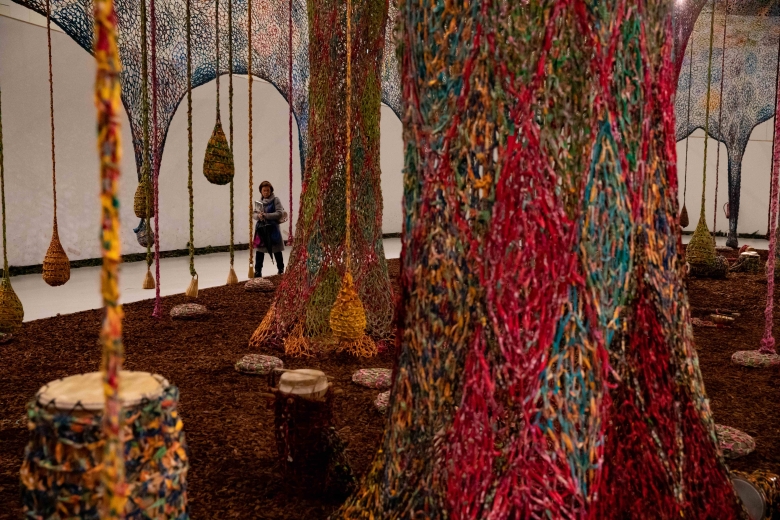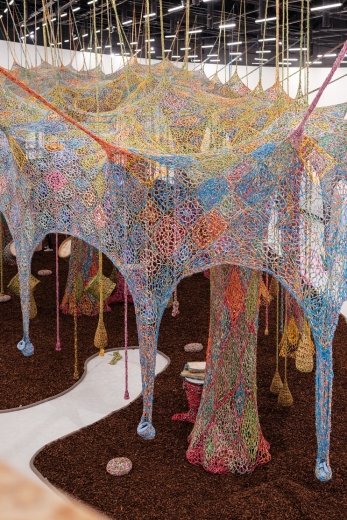
Ernesto Neto, one of Brazil's most international and well-known artists, presents an immersive installation that evokes the crossing of cultures between different continents.
Curated by Jacopo Crivelli Visconti, Nosso Barco Tambor Terra [our boat drum earth] is one of the largest sculptures Ernesto Neto has ever made. Its shape is a product of months of work, in dialogue with MAAT’s architectural space and the museum's surroundings, richly imbued with history and symbolism as the departure point for the caravels that set sail for what would come to be known as the Americas.
Using images (sails) and materials (canvas and ropes) generally associated with transatlantic voyages, Ernesto Neto creates a set of unprecedented installations that occupy the venue's different dimensions. To create the work, Neto used mostly chintz, a relatively cheap cotton fabric that is extremely common in Brazil, often printed with brightly coloured flowers and plants. The fabric was cut into strips and crocheted by various assistants, based on a technique developed over the years in the artist’s studio in Rio de Janeiro: atelienave. The material thus obtained was used to create the cells that together compose the sculpture. The work’s overall plan is developed freehand, through tests and adjustments supported by specific software that allows for precision but also sufficient malleability to adapt to the specificities of the space at the time of mounting in situ.
In recent years, alongside his activity as an artist, Neto has also devoted himself to percussion. Throughout the exhibition, the sculpture, which incorporates a series of instruments, will be periodically activated by a musical programme, devised by musicians and groups from various parts of the world, with particular emphasis on the rhythms of African and Asian diasporas. Symbolically, the meeting of rhythms and beats in Nosso Barco Tambor Terra forms a counterpoint to the multitude of languages spoken around the world, alluding to the possibility of finding, in specific moments and contexts, common languages that allow a communication that transcends the verbal and facilitates authentic and profound encounters. Consistent with the artist’s desire to create a truly collective and diverse work, various drums from a range of provenances that inhabit the installation can also be played by visitors to the exhibition.
The musical programme, curated by Ernesto Neto and Tânia Lopes, will be announced soon.
Guided tours
Everyday except Tuesdays: 13.00 and 16.00
[Free entrance with the museum ticket]
Track recorded on the occasion of the exhibition "Nosso Barco Tambor Terra" by Ernesto Neto at MAAT – Museum of Art, Architecture and Technology, Lisbon.
The Contemporous Art
Text by Ernesto Neto
It seeks to go beyond the surface, beyond the plain, the signifier and the signified; it seeks to be inside the body, uniting the physical, mental, spiritual and ancestral body; it seeks transparency and materiality, to unite the diverse; it is naturally relational, symbiotic, mutualistic, multinatural. It believes in the wisdom of the fingers; it desires to touch and be touched, to exchange, to feel through the pores. It distrusts cultures that believe they are superior to nature, as it believes we too are nature; it respects fragility, exposes tensions, but observes limits; it wants to touch the world with care, attention and love. It knows that poetry is here, now in the silent song of our breathing, in and out, for smiling is our connection with being at peace, in the time between heaven and earth. Contemporous art is friends with the common boa, the serpent and the kundalini; it knows that light vibrates in both waves and packets of energy, and that the two things are not mutually exclusive; on the contrary, they are complementary, yin and yang at the same time. It studies the continuity between bodies, between mind, hand and earth; it sees planet Earth as a body, not as landscape; it sees itself as part of the body of Earth, as well as part of the whole universe – or should one say of the whole multiverse? It worries about the contemporary devotion to the world of objects, but also uses them; it knows objects are the defining expression of humans' being, and knows that they, despite their artificiality, are also nature, that beyond all the matter they are made of, all the science applied in developing them, even the AI star, everything is nature, there is nothing outside of it. Contemporous art is amorous, praises the vibrant force of the drum, the caxixi, the flute, the guitar, the maraca, of song and singing, learning from early on that joy is healing. It cherishes social balance: no one is greater than nature just as no one is greater than anyone else, we all have to make our contribution, Our Ship Humanity Planet Earth needs everyone: us, insects, bees, plants, trees, animals, fungi, lichens, bacteria... as in a batucada, we all need to stick together, at the same tempo, Umbuntu, neither in front nor behind; there is room for the individual expression of each and every one, but between the beginning and end of each cycle we must stay together so the balance and brilliance of all makes room for the brilliance, the trance and well-being of each.
MAAT patron and exhibition sponsor:

Support:
Margão

Fotografia: Bruno Lopes

Fotografia: Bruno Lopes

Fotografia: Bruno Lopes

Fotografia: Bruno Lopes

Fotografia: Bruno Lopes

Fotografia: Bruno Lopes





